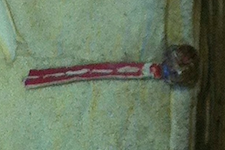When talking about manuscripts with the uninitiated, I usually mention how features that guide us through our modern books – running titles, subheadings, and indices, for example – originated in the Middle Ages. Yet, I tend to overlook bookmarks (despite my childhood collection of them) as a sort of ‘separate apparatus’. Bookmarks, however, also have an interesting medieval past!
Unlike today’s kitten-adorned cardboard versions, or the crocheted worm variety (my personal favourite), medieval bookmarks tended to be less decorative, but über practical. There are essentially three types of bookmark, most of them extant from the twelfth century onwards* and usually found in liturgical books (as the Mass celebrant had to locate various readings in several different books depending on the day).
1) Fore-edge Bookmarks
This type is arguably the ancestor of today’s binder or index tab. A tab made out of a bit of parchment (sometimes cut from the edge of the page itself), coloured leather, or even a sort of woven bead, was stitched onto or looped through a cut in the page at the height of the desired text. These may have also been used to mark the beginning of different texts in a composite manuscript, or different chapters.

Knotted tab in the left margin, likely marking a new text in a formerly composite manuscript. Bruges City Library, MS 47, 1v-2r, 3rd quarter 12th c. Photo Jenneka Janzen.

Close-up of knotted tab, Bruges City Library, MS 105 front flyleaf, c. 1175-1200. Photo Jenneka Janzen.

Tab made from the page itself (recto and verso of same folio). Oxford, Balliol College, MS 86, 14th c. Photo Balliol Archives conservationist blog.
2) Register Bookmarks
Probably closest to modern bookmarks, the register bookmark comes in three smart versions. The simplest is similar to what you’d find in a nice edition today – a long strip of parchment, leather, string, or ribbon attached to the endband or spine of the book that could be draped between pages. There might be several ribbons, for the reader to mark several pages.

Manuscript endband with register bookmark and foot with trailing cords. Auckland Libraries, Sir George Grey Special Collections, Med. MS S.1588. Photo Alexandra Gillespie, from her blog Medieval Bookbindings.
Another variation on this theme was the portable register, made by attaching a number of strings or strips to an anchor (a peg or square of parchment or leather), which rests at the top edge of the book.
The third version of the register bookmark is the most ingenious! A little rotating dial made of parchment is added to the bookmark string, usually with numbers one through four marked on it signifying the standard four columns of text at each opening (i.e. column A and B verso, and column A and B recto). When the reader wanted to mark his spot, he slid the dial up or down the string to line up with the spot he wanted to mark, and then indicated, using the wheel’s markings, the desired column.

Register bookmark with adjustable dial set between column II and III (i.e. col. B verso and col. A recto[not pictured]). Harvard University, Houghton MS Typ 277, 12th c.
The last type of bookmark is the most obvious: the found object, or essentially whatever-happens-to-be-at-hand bookmark. Much in the way we might re-purpose an old shopping list or photo, medieval readers used parchment scraps, bits of string, or pieces of plants to mark their spot. Turning Over a New Leaf project leader Erik Kwakkel found a lovely leaf bookmark in an incunabula in Zutphen.

Leaf bookmark found by Erik Kwakkel in an incunabula in Zutphen’s chained library. Photo Erik Kwakkel. See more on his Tumblr.

Auckland Libraries, MS G. 185, Photo Alexandra Gillespie, from her blog Medieval Bookbindings.
Despite their attraction, medieval bookmarks are often left unmentioned in special collections catalogues, making them interesting little surprises for manuscript scholars. Want more on bookmarks? Stay tuned to upcoming Turning Over a New Leaf blog entries!


